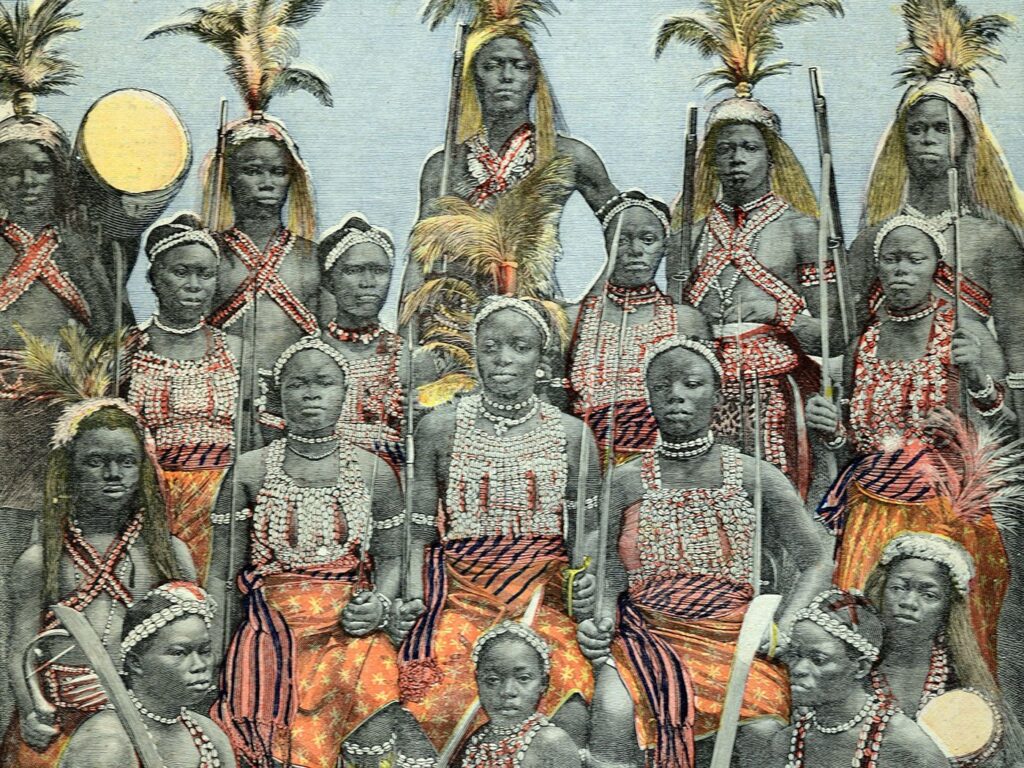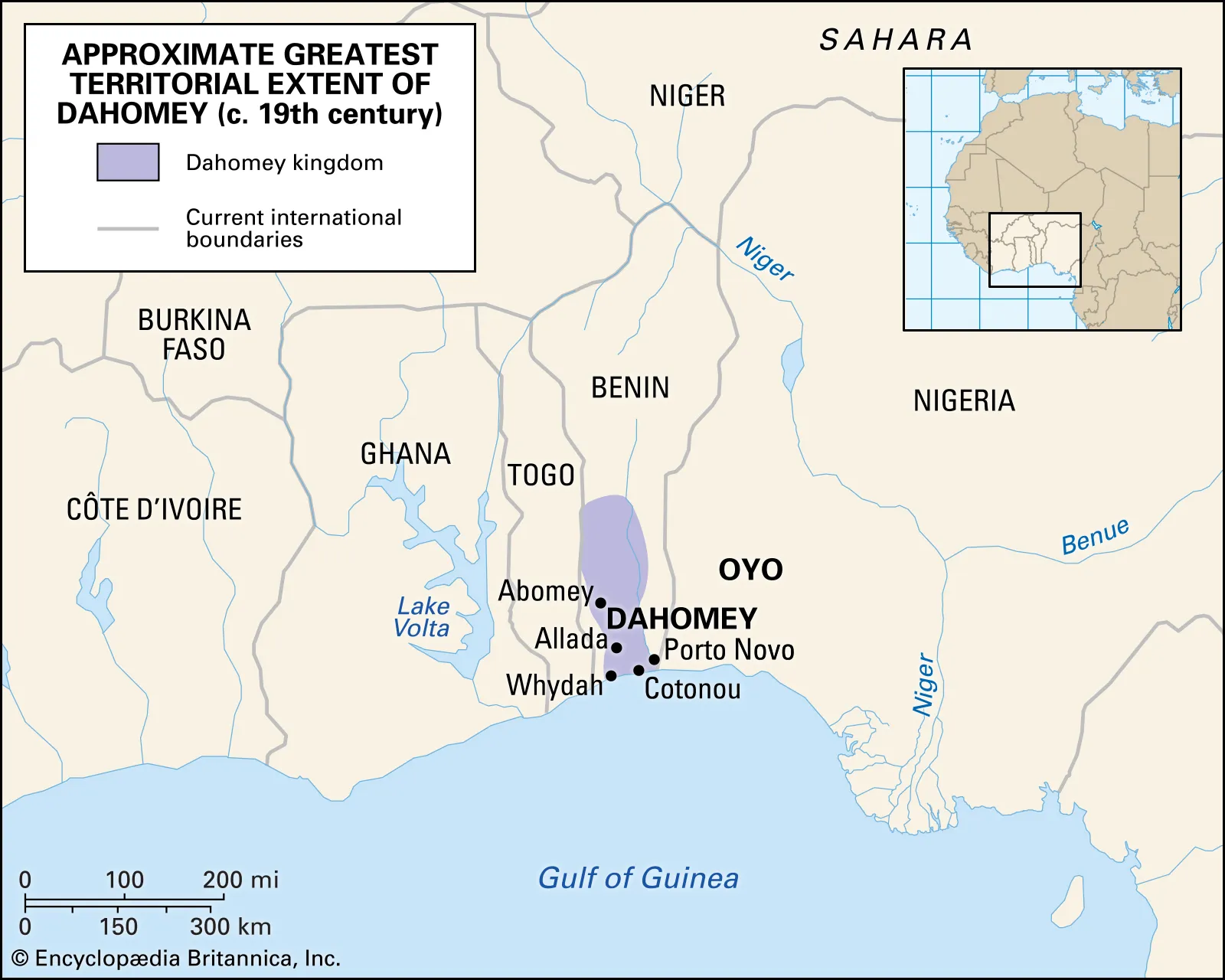The Agojie were a fierce, stealth force of women warriors that others feared and rightfully so. The Agojie first formed around the early 1700s in the Kingdom of Dahomey likely under the woman king (poteeto in the Fon language), Tassi Hangbe as her royal guard. Queen Hangbe was the twin sister of King Akaba (1685-1715) and she ruled the Kingdom of Dahomey after her brother’s death for a few years until her youngest brother, Agaja took reign in 1718. King Agaja expanded the kingdom by overtaking Allada (1724) and Ouidah or Whydah (1727), prospering on the slave trade of Africans to Europeans.
The Dahomey Kingdom was formally founded by Huegbadja between the mid to late 1600s. Huegbadja’s son (mentioned above), Akaba succeeded him after his death. Prior to Huegbadja’s reign, the nobility who controlled the region of Abomey, which would later become the Kingdom of Dahomey commenced from Ganyehesu and his brother who succeeded him, Dakodonu. There are varying accounts of Huegbadja being the son of Dakodonu, but more evidence points to Huegbadja’s origins being elsewhere.
King Huegbadja’s Origins & Coming to Power
Huegbadja’s mother, Adru came from the powerful Awesu (Ahodomen) family in Dokon, 5 km from the capital of Abomey. Huegbadja’s father, Awusa was a Hwla king from the Lake Aheme area, southwest of the Abomey plateau, which borders present-day Togo. As a young man Huegbadja was ousted from the Hwla region by his father for having violated a young girl. When he arrived in Abomey, because of his mother’s strong familial reputation amongst the local people, he gained the trust of the indigenous people and earned a reputation for being a tenacious hunter and warrior. Huegbadja influenced local chiefs with gifts and was ultimately able to gain power with the support of his mother.
The Agojie’s Prominence
“The Agojie’s divisions consisted of five branches: blunderbuss or artillery women, elephant hunters, musketeers, razor women and archers. Surprising the enemy was of the utmost importance. Warriors snuck up on villages at or before dawn, taking captives and decapitating those who resisted.” These women were recruited often as slaves or prisoners of war from enemy nations or local girls who were rebellious. The Agojie were “ahosi” and considered the king’s wives, albeit “third-class wives” as they did not “share his bed” nor have any children with him. Therefore, the Agojie were sworn to celibacy, but many did become pregnant, including in situations that likely “involved consensual sex.” After their military service, some Agojie did marry and have children.
These women were not only warriors, but many of them also had royal cabinet positions and advised the king. In fact, women in general had significant official roles in the kingdom with each male official “in the field” having a female counterpart in the royal court, who observed the former’s conduct and provided counsel to the king.
The Agojie peaked with 8,000 women warriors under the reign of King Ghezo (1818-1858), who formally incorporated them into Dahomey’s army as previous wars caused a decline in the male population.
The film, ‘The Woman King’ depicts the Dahomey Kingdom in 1823 when King Ghezo ruled, which include some accurate narratives such as the kingdom of Dahomey withdrawing its allegiance to the Oyo Empire and the rigorous training of new Agojie recruits. However, King Ghezo did not decisively abandon the slave trade for palm oil production because the exporting of palm oil proved to be far less lucrative than the slave trade, so he resumed the trade. The Agojie force was a key component of sustaining the enterprise of the slave trade. During their enlistment, the Agojie had to capture prisoners to be sold in the slave trade while risk being captured and sold as enslaved people themselves.
By 1852, after years of pressure from the British, King Ghezo finally ended the slave trade. Ghezo’s son, Glele took reign from 1858 to 1889 and although his father successfully made a complete transition to palm oil exports, the kingdom experienced economic contraction. The Dahomey Kingdom, under the leadership of King Ghezo’s grandson Béhanzin (1889-1894) fell to the French in the 1890s. Many Agojie died fighting the French including Nanisca when the Dahomean army attacked the French at Cotonou on March 4th, 1890. Nanisca, played by Viola Davis in the film, ‘The Woman King’ was a real Agojie warrior, although the character depicted in the film was fictional. After suffering thousands of losses in a seven week span of war, Béhanzin went into exile in Martinique in 1894.
The French installed Béhanzin’s brother as a “puppet king,” and Dahomean society became fragmented with people following Béhanzin to Martinique and others touring the U.S. and Europe. French colonization took away the rights and opportunities of women including the Agojie and suppressed the rich history along with the royal fortitude of Dahomey Kingdom.
Sources: “The Real Warriors Behind ‘The Woman King'” – Smithsonian Magazine
Dahomey, historical kingdom – Encyclopedia Britannica
“What ‘The Woman King’ gets wrong — and right — about Dahomey’s warriors” – The Washington Post
No related posts.



